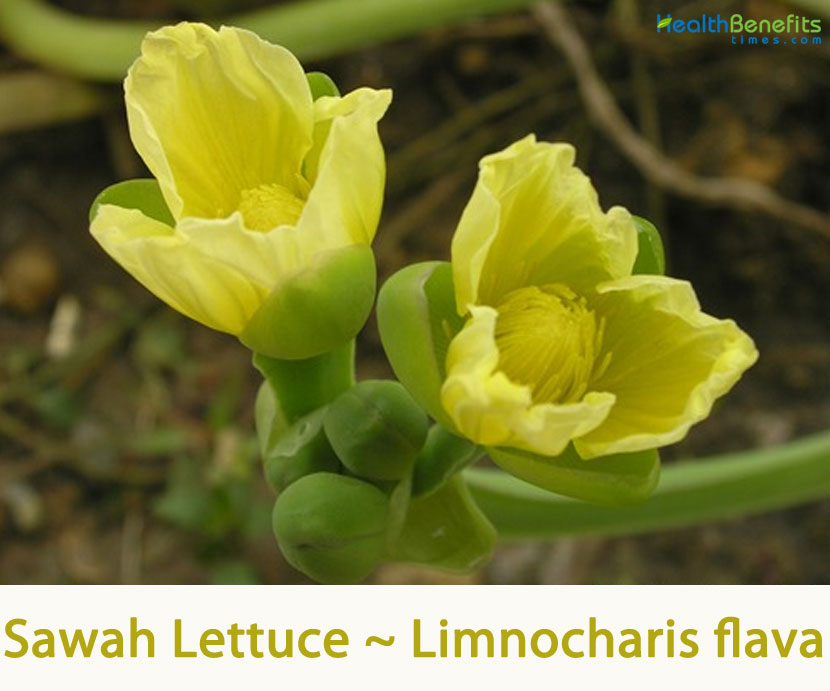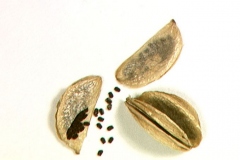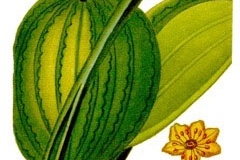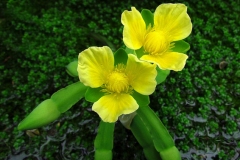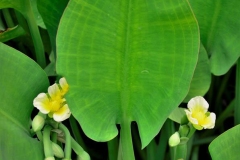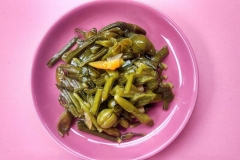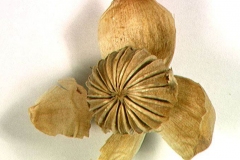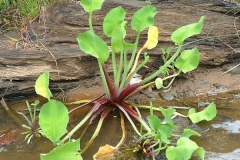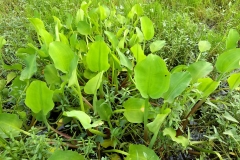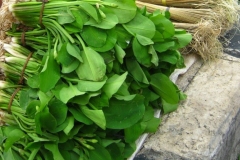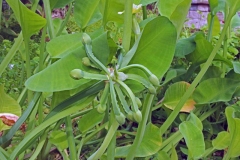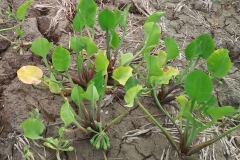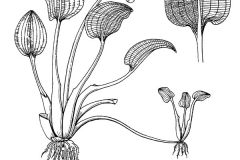| Sawah Lettuce Quick Facts | |
|---|---|
| Name: | Sawah Lettuce |
| Scientific Name: | Limnocharis flava |
| Origin | Mexico, the Caribbean, Central America and tropical South America |
| Shapes | Rounded capsules' (i.e. spherical follicles), 15-20 mm across, that split up into several (10-20) floating segments when mature |
| Health benefits | Rejuvenation of body cells, Strengthen bones, Anemia, Natural Anti germs, Good for pregnant women, Prevent colon cancer and prevent constipation, Cure the risk of heart disease and cancer, Maintain digestive system, Increase appetite, Maintain tooth strength, Adds energy, Increase endurance, Rejuvenate the skin |
| Name | Sawah Lettuce |
|---|---|
| Scientific Name | Limnocharis flava |
| Native | Mexico, the Caribbean (i.e. Cuba, the Dominican Republic, Grenada and Haiti), Central America (i.e. Costa Rica, Nicaragua and Panama) and tropical South America (Venezuela, Brazil, Bolivia, Colombia, Ecuador, Peru, northern Argentina and Paraguay). It is widely naturalized in southern and southeastern Asia: India, Sri Lanka, Cambodia, Burma, Thailand, Vietnam, Indonesia, Malaysia, Brunei and southern China (Guangdong, Yunnan) |
| Common Names | Yellow sawah lettuce, yellow burr head, yellow velvetleaf, Sawah Lettuce, Sawah Flowering Rush, Bak kanjong, Bengok, Berek, Bon cheen, Etjeng, Genjur, Jinjir, Keo neo, Ne thao, Phak kanjong, Phak pai, Sawah-flower rush, Talapat Rusee, Trakiet paong, bur head, limnocharis, Hermit’s Waterlily, Limnocharis |
| Name in Other Languages | Afrikaans: Velvetleaf Albanian: Velvetleaf Amharic: Velvetleaf (velvətˌlēf) Arabic: Almukhmalia (المخملية) Armenian: T’avshan (թավշան) Azerbaijani: Məxmər Bengali: Velvetleaf, Haladēpānā (হলদেপানা), Kalmi, Kengkong Brazil: Barata Bulgarian: Karkade (каркаде) Burmese: Kat te par (ကတ္တီပါ) Cambodia: Trakiet Chinese: Tiān éróng (天鹅绒), huang hua lin (黄花蔺) Croatian: Mračnjak Czech: Velvetleaf, Žabníkovka žlutá Danish: Fløjlsblad Dutch: Fluwelen blad, Gele Sawahsla English: Velvetleaf, Sawah-flower-rush, Sawah-lettuce, Yellow velvetleaf, limnocharis, sawah-flower rush, sawah-lettuce, velvetleaf, yellow bur-head, Sawah flowering rush Esperanto: Velureto Estonian: Sametkõht Filipino: Velvetleaf Finnish: Samettilehti French: Feuille de velours, buchon Georgian: Khaverdovani (ხავერდოვანი) German: Samtblatt, gelber Froschlöffel Greek: Veloúdo (βελούδο) Gujarati: Makhamala (મખમલ) Hausa: Velvetleaf Hebrew: עלה קטיפה Hindi: Velvetleaf Hungarian: Selyemmályva Icelandic: Flauelleaf Indonesian: Velvetleaf, Genjer, jinjir, paku rawan, Bengok, Berek, Gènjèr, Gunda Wehehan, Tempujung, Timpujung, Tjèntongan, Chengtongan, Wewean, Wewehan, Echeng, Endjer, Bang- Eng, Gèndjèr, Gendot, Saber Irish: Veilbhit Italian: Velvetleaf Japanese: Birōdorīfu (ビロードリーフ), Kibana Omodaka (キバナオモダカ) Javanese: Velvetleaf, Gènjèr Kannada: Velveṭlāph (ವೆಲ್ವೆಟ್ಲಾಫ್) Kazakh: Barqıt japırağı (барқыт жапырағы) Korean: Belbes ip (벨벳 잎) Kurdish: Velvetleaf Lao: Velvetleaf, Kaanz Choong Phak Khan Chong Latin: Velvetleaf Latvian: Samtainais Lithuanian: Aksominis Macedonian: Kadife (кадифе) Malagasy: Velvetleaf Malay: Velvetleaf, Pokok Keladi Senduk Malaysia: Emparuk, Kakatung, Balehir, Ètjèng, Paku Rawan, Jinjir Malayalam: Velvetleaf, Manja Payal Maltese: Bellusell Marathi: Makhamalee (मखमली) Mongolian: Khilen navch (хилэн навч) Nepali: Makhamalee (मखमली) Norwegian: Velvetleaf Oriya: Velvetleaf Pashto: مخمل Persian: مخمل Philippines: Cebolla De Chucho Polish: Aksamitny Portuguese: Folha de veludo, Golfe, barata Punjabi: Makhamalī (ਮਖਮਲੀ) Romanian: Catifelate Russian: Teofrasta (Теофраста) Serbian: Velvetleaf (велветлеаф) Sindhi: مخمل Sinhala: Velvetleaf Slovenian: Zametnica Spanish: Velvetleaf, cebolla de chucho, hoja de buitre Sudanese: Velvetleaf, Génjér Swedish: Velvetleaf, Sammetssvalting Tajik: Velosiped (велосипед) Tamil: Velvetleaf Telugu: Velveṭlīph (వెల్వెట్లీఫ్) Thai: Velvetleaf, Tālpạtrvɨs̄ʹī (ตาลปัตรฤๅษี), Bonchin, Talapatrusi, Nangkwak Turkish: Kadife Ukrainian: Oksamytovyy (оксамитовий) Urdu: مخمل Uzbek: Kadife barglari Vietnamese: Nhung, Cù Nèo, Kèo Nèo Welsh: Velvetleaf Zulu: Velvetleaf |
| Plant Growth Habit | Erect, flowering, clump-forming, perennial herbaceous plant that grows in both aquatic and swampy terrestrial environments |
| Growing Climates | Shallow swamps, ditches, pools and wet rice fields, occurring usually in stagnant freshwater bodies of water (i.e. dams, lakes and ponds), slow moving waterways, wetlands, marshes, irrigation channels, drainage ditches and ponded crops (e.g. rice |
| Plant Size | Grows 20-120 cm tall |
| Root | Fibrous roots have a thick and erect rhizome, immersed in mud and brownish white |
| Leaf | Leaves are yellow-green, smooth and hairless (i.e. glabrous) and consists of a milky sap (i.e. latex). They are borne on long three-angled stalks (i.e. trigonous petioles) 5-90 cm long and have rounded (i.e. orbicular) leaf blades. The leaf blades are orbicular (approximately circular in outline), broadly elliptic or ovate in shape, with 9-13 main nerves and numerous secondary nerves running in parallel |
| Flower | Individual flowers are 2-4 cm across and are borne on short thick stalks (i.e. pedicels), 2-7 cm long, that emerge from the same point at the top of the flowering stems (i.e. they are arranged in an umbel). There are usually some small papery bracts present amongst the flower stalks (i.e. pedicels). Each flower has three large pale yellow petals (2-3 cm long and 1-2 cm wide); three overlapping green sepals are 15-20 mm long and 10-15 mm wide, and a cluster of numerous bright yellow stamens at its center. |
| Fruit Shape & Size | Rounded capsules (i.e. spherical follicles), 15-20 mm across, that split up into several (10-20) floating segments when mature |
| Seed | Seeds are 1-1.5 mm long, dark brown in color and horseshoe-shaped |
| Propagation | By seed and vegetative shoots |
| Health Benefits |
|
Plant Description
Sawah Lettuce is an erect, flowering, clump-forming, perennial herbaceous plant that grows in both aquatic and swampy terrestrial environments. The plant roughly grows about 20-120 cm tall from a short thick rhizome. Its triangular-shaped leaves and hollow stems are hairless. The plant is found growing in shallow swamps, ditches, pools and wet rice fields, occurring usually in stagnant freshwater bodies of water (i.e. dams, lakes and ponds), slow moving waterways, wetlands, marshes, irrigation channels, drainage ditches and ponded crops (e.g. rice). In ephemeral bodies of water that experience a dry season, this plant will grow as an annual. This plant is highly aggressive and will quickly establish in any shallow freshwater.
Stems
The very large and somewhat fleshy leaves arise from the base of the plant, and are borne in clusters along a short thick upright (i.e. erect) stem about 3cm long and 3 cm wide.
Leaves
The leaves are yellow-green, smooth and hairless (i.e. glabrous) and consists of a milky sap (i.e. latex). They are borne on long three-angled stalks (i.e. trigonous petioles) 5-90 cm long and have rounded (i.e. orbicular) leaf blades. The leaf blades are orbicular (approximately circular in outline), broadly elliptic or ovate in shape, with 9-13 main nerves and numerous secondary nerves running in parallel. They are 5-30 cm long and 4-25 cm wide and have blunt tips (i.e. obtuse apices) and entire or wavy (i.e. undulate) margins.
Flowers
The flowers are borne in loose clusters (containing 2-15 flowers) at the top of long stalks (20-120 cm long). These upright flower stalks (i.e. erect peduncles) emerge from the base of the plant and are three-angled (i.e. trigonous), like the leaf stalks (i.e. petioles). About one to four of these flowering stalks are produced amongst each cluster of leaves. The individual flowers are 2-4 cm across and are borne on short thick stalks (i.e. pedicels), 2-7 cm long, that emerge from the same point at the top of the flowering stems (i.e. they are arranged in an umbel). There are usually some small papery bracts present amongst the flower stalks (i.e. pedicels). Each flower has three large pale yellow petals (2-3 cm long and 1-2 cm wide); three overlapping green sepals are 15-20 mm long and 10-15 mm wide, and a cluster of numerous bright yellow stamens at its center. Flowering occurs throughout the year, depending on conditions (i.e. it usually flowers during wetter periods).
Fruit
The upright flower stalks (i.e. peduncles) begin to droop as the fruit mature, and the persistent sepals become enlarged and enclose the developing fruit. The fruit are rounded capsules’ (i.e. spherical follicles), 15-20 mm across, that split up into several (10-20) floating segments when mature. Each segment is semi-circular in shape and contains numerous ridged seeds that are 1-1.5 mm long that are dark brown in color and horseshoe-shaped. Mature seed capsule consists of around 1000 seeds and will split into multiple floating segments, aiding in dispersal. Although it is not a floating plant, its seeds are carried away by currents.
Health benefits of Sawah Lettuce
For some, the Yellow Velvetleaf (Limnocharis flava) utilized as livestock feed, so as not to become a weed in rice fields. But who would have thought that the Yellow Velvetleaf can also be consumed as well as the man believed to have a variety of benefits that are good for the body. Following are some of the benefits that can be obtained from the consumption of Yellow Velvetleaf
1. Rejuvenation of body cells
Yellow Velvetleaf has a protein content to help rejuvenate the cells in the body. By consuming Yellow Velvetleaf, millions of cells that are not functioning in your body can be replaced with a new one. Additionally, the protein content coupled with iron content in Yellow Velvetleaf is also useful in speeding up the healing process of wounds on the body.
2. Strengthen bones
Yellow Velvetleaf consists of calcium and phosphorus, which has an important role in bone growth in children, even the content can also support the growth of teeth in children. Whereas in adults, calcium and phosphorus plays a role to strengthen the bones and prevent osteoporosis.
3. Anemia
Consumption of Yellow Velvetleaf can help you to cope with less blood (anemia). This is because Yellow Velvetleaf consists of iron, which can help the body in shape and fixing of red blood cells in the blood.
4. Natural Anti germs
Yellow Velvetleaf may also be useful as anti-natural germ if you consume it. This is due to the womb flavonoid on Yellow Velvetleaf can be used as an anti-germ.
5. Good for pregnant women
For pregnant women, Yellow Velvetleaf is also beneficial to help fulfill his nutritional needs. Protein content on velvetleaf worthwhile to help increase energy needed for pregnant women and assist in the formation of muscle cells in the fetus.
6. Prevent colon cancer and prevent constipation
Colon cancer usually occurs due to improper diet and the impact due to the not smooth digestion. Sawah Lettuce consists of high fiber so as to function in digestion. Someone who consumes Sawah Lettuce regularly, it is certain that he will be away from the risk of colon cancer. Additionally, research suggests that people who regularly consume Sawah Lettuce will not be affected by constipation (constipation).
7. Cure the risk of heart disease and cancer
The content of polyphenols in Sawah Lettuce can act as antioxidants; this content can prevent heart disease and cancer.
8. Maintain digestive system
10. Sawah Lettuce has a high enough fiber content that is excellent for your digestive system. For those who have difficult bowel, Sawah Lettuce is very good to treat it.
9. Increase appetite
If you eat a Sawah Lettuce stir, there is a bit of bitterness. But this bitter taste gives a sensation that makes your appetite will increase.
10. Maintain tooth strength
Calcium and phosphorus in the Sawah Lettuce are wonderful for dental health. Teeth will not be easily porous if you consume Sawah Lettuce regularly.
11. Adds energy
Usually, our energy needs are obtained from foods such as rice, tubers, etc. You would not imagine that the Sawah Lettuce could be a source of energy. This is because Sawah Lettuce also consists of a high enough carbohydrate. Consumption of Yellow Velvetleaf can help the body to gain energy reserves which at any time may be needed by the body.
12. Increase endurance
Sawah Lettuce consists of vitamin B1 compounds. This vitamin has the function of improving endurance. If you are feeling feverish or unwell, then eat the Sawah Lettuce so that your body will be healthy again.
13. Rejuvenate the skin
Water-rich Sawah Lettuce will keep your skin in good moisture condition. So it is not easy to dry and will look bright.
Traditional uses and benefits of Sawah Lettuce
- Yellow velvetleaf is helpful for people with hyperglycemia.
- Yellow velvetleaf is also beneficial for digestion because it contains fiber dissolved in water.
- It can relieve constipation and flatulence because the yellow velvetleaf plant is carminative.
- Yellow velvetleaf plants contain lots of calcium, phosphorus, and iron. Calcium and phosphorus are macro elements necessary for bone formation.
- Iron and vitamin A in the yellow velvetleaf plant helps to fulfill the production of red blood cells to prevent anemia.
Culinary Uses
- Leaves, leaf stems, flower stalks and young inflorescences are eaten cooked.
- They can be steamed like endive or spinach, added to soups or mixed with other vegetables.
- Young leaves and tops of the plant are boiled or cooked in mixed soups.
- Vegetable consists of relatively high levels of Calcium, Iron and vitamin A, which are nutrients that are frequently insufficient in the diets of women in low-income countries.
- In Indonesia, Malaysia and Thailand, the young leaves with petioles attached, are eaten as a vegetable, usually heated over fire or cooked a short time before consumption.
- The young unopened inflorescences are also eaten.
- Traditionally this plant is an important vegetable in parts of Indonesia, the Philippines, Vietnam, Laos, Isan (Thailand) and parts of India, where the central flower stalk and the leaves are used in soups, curries, salads and stir-fries.
- The immature flower buds are also eaten.
- In Isan the leaf is eaten raw with nam phrik.
- Owing to its flat taste, in some areas it is considered “poor people’s food” or emergency food, eaten whenever there is not much else left.
- It is a very popular and common vegetable in India, Vietnam, Thailand, Laos, Cambodia, Malaysia and Indonesia.
- In Vietnam, the leaves, flower and petiole are eaten as vegetables commonly by dipping in steam boat dishes with other vegetables.
- In Sabah, they are boiled and eaten as salad or fried with shrimp paste or boiled with other vegetables.
- In Sarawak, similar parts are blanched in hot water or slightly heated over a fire before being eaten as ulam.
- It is also prepared as a cooked vegetable and eaten like spinach.
- In Thailand, young inflorescences are collected and eaten fresh with chilli sauce and as side dish together with other hot and spicy dishes.
Stir-fry Sawah Lettuce
Ingredients
- Sawah Lettuce little bunch
- garlic cloves
- Shallots Cloves (many can)
- curly red chilies
- half red tomatoes
- Tempe 2x2x3 cm; ground / half finely ground
- 2 teaspoons already rebon
- 2 tablespoon of cooking oil
- half a teaspoon of white sugar (use more tasty red gule)
- salt to taste
Directions
- Heat oil in a frying pan (don’t be too hot mom); if it’s too hot the vegetables will not be fresh green the eyes, but withered.
- Add the entire spice sliced until half cooked
- Mix our natural flavoring (ulekan tempe) and rebon, sauté until cooked.
- Enter Sawah Lettuce/ vegetables that have been washed and cut.
- Add a little water (about 3 tablespoon).
- After almost done, add sugar and salt
- After taste ok and according to taste close briefly, less than a minute so that the taste blends (30 seconds)
- Turn off the stove, and transfer the ripe vegetables to the container, so that it doesn’t wither.
Best practice management
Sawah Lettuce is one of the species targeted for national eradication under the National Resource Management Ministerial Council’s National Cost-Sharing Eradication Programs. These programs map and monitor the full distribution of the species, and coordinate or undertake activities to eradicate that species from Australia. Eradication programs for Sawah Lettuce have been undertaken in Centenary Lakes, Cairns, and the Townsville district.
Chemical control
Varieties of Sawah Lettuce have demonstrated herbicide resistance in Malaysia and Indonesia.
Non-chemical control
Physical control
With unusual foliage and attractive flowers, Sawah Lettuce is likely to be lurking unrecognized in suburban backyards, especially those featuring ‘Asian water gardens’. Early detection and measures to prevent the spread of this weed are the best ways to control it. Report any findings to your local authority or weed management agency. Specimens will need to be positively identified at your state or territory herbarium, and specialist assistance should be sought to minimize the risk of accidental dispersal of the tiny seeds. All occurrences must be reported and fully documented before removal, to facilitate follow-up as part of the national eradication campaign. Infested sites need ongoing inspection to prevent re-infestation from the seed bank.
Prevention
Sawah Lettuce is banned from being imported into Australia, and should not be sold by plant nurseries or cultivated in ponds and water gardens.
Other Facts
- The plant is also used for green manure.
- Fruiting takes place throughout the year, with a single fruit producing about 1,000 seeds and a single plant producing about 1,000 fruits per year.
- Whole plants are used as pig or fish fodder and also ploughed into rice fields as green manure.
- The plant is also often used as an ornamental plant in ponds.
- It is valued as an ornamental plant in some countries and cultivated in botanic gardens or private homes.
- Slime from the plant is used as soap.
- The plant is also grown as ornamentals in ponds.
- It is deemed a major noxious weed in many countries as it forms dense, choking infestations that obstruct water flow.
- It is a serious weed of rice fields, waterways, lakes and irrigation canals.
References:
https://www.itis.gov/servlet/SingleRpt/SingleRpt?search_topic=TSN&search_value=503462#null
http://www.hear.org/pier/species/limnocharis_flava.htm
https://pfaf.org/user/Plant.aspx?LatinName=Limnocharis+flava
https://www.nparks.gov.sg/florafaunaweb/flora/2/1/2196
http://www.theplantlist.org/tpl1.1/record/kew-280510
https://keyserver.lucidcentral.org/weeds/data/media/Html/limnocharis_flava.htm
https://en.wikipedia.org/wiki/Limnocharis_flava
https://gd.eppo.int/taxon/LMNFL
https://www.flowersofindia.net/catalog/slides/Yellow%20Sawah%20Lettuce.html
http://tropical.theferns.info/viewtropical.php?id=Limnocharis+flava
https://plants.usda.gov/home/plantProfile?symbol=LIFL5
https://www.cabi.org/isc/datasheet/30804


